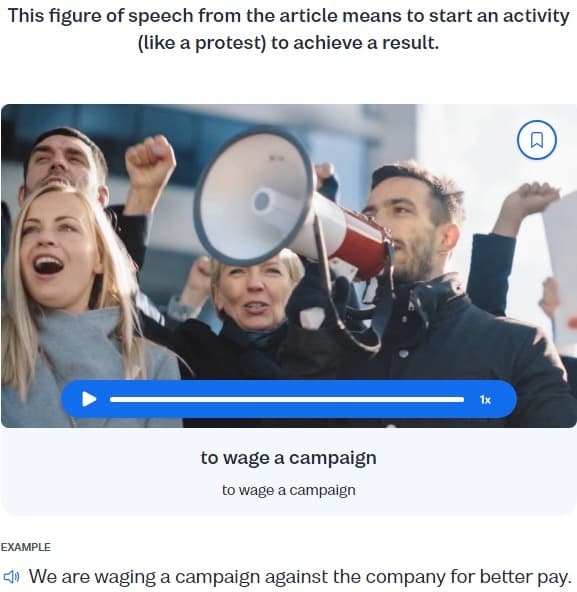I want to learn...
Author:

Barney Meekin
At some point in your language learning, everyday language will become easy. You’ll know what to say in most situations and you’ll have few problems communicating, reading, or writing. When you reach this stage, you can easily live and work in your new language.
But, the learning doesn’t stop. You won’t be struggling to do the day-to-day stuff anymore, so you can start to use language creatively. You’ll also be able to read and understand the hidden meanings in literature. To do both of these things, you need to understand figures of speech.
In this article, you’ll learn about 20 figures of speech with examples from literature.
What is a figure of speech?
A figure of speech is a way of using language creatively — not everyday language — to create an effect. It’s the opposite of the straightforward language you’ll encounter in everyday life. You’ll find figures of speech mostly in written English (novels, poems, okays, etc) but you'll come across them in spoken English sometimes too.
20 of the most common figures of speech (with examples from literature)
Let’s dive in. Figures of speech come in five main categories. For each figure of speech, you’ll find the reason to use them and famous examples from English literature.
Figures of resemblance or relationship
1. Analogy
Analogy is all about making comparisons — linking two different ideas to make things easier to understand. Analogies create a clear picture in your reader’s (or listener’s) mind.
Let’s look at an example from Shakespeare. In this analogy, he compares the world to a stage, and life to a play.
"All the world's a stage,
And all the men and women merely players."
By William Shakespeare, As You Like It
2. Metaphor
Use metaphors to bring your words and images to life. You can create vivid images, helping your readers or listeners picture what you’re talking about.
In the below example, the character is talking about burning books. By comparing burned pages to “beautiful black butterflies,” the author creates a memorable image. One that also shows a lot about the character’s point of view.
“Light the first page, light the second page. Each becomes a black butterfly. Beautiful, eh?”
By Ray Bradbury, Fahrenheit 451
2. Metonymy
You can use metonymy to make your language more concise. Metonymy is when you swap long phrases for shorter, related ones. It’s almost like a nickname for concepts. Writers use metonymy to create imagery or to add depth to meaning.
In this example from Moby Dick, “hands” means all of the men on the ship.
“The probability would be that he and his shipmates would never again remember it, on account of all hands gently subsiding to the bottom.”
By Herman Melville, Moby Dick
3. Parallelism
Parallelism is when you use the same grammar in clauses, sentences, or paragraphs. This can be as simple as making sure each item on a list is a noun. Parallelism simplifies the structure and improves the flow of your speaking or writing. It’s also a great way to show the connections between things.
In this example, Charles Dickens repeats the phrase “It was the” at the start of each clause. The parallelism in this example contrasts with the contradictions that follow it for effect.
"It was the best of times, it was the worst of times, it was the age of wisdom, it was the age of foolishness..."
By Charles Dickens, A Tale of Two Cities
4. Personification
Personification is when you make non-human things sound human. You can do this to make objects (or concepts) more relatable to your reader or listener. When you use it for concepts and ideas, it helps create a concrete image.
In this example, Emily Dickinson makes Death sound like a gentleman with good manners. She does this to make a frightening experience more relatable to her readers.
“Because I could not stop for Death –
He kindly stopped for me”
By Emily Dickinson, Because I could not stop for Death
5. Simile
Similes are very similar to metaphors. You use them to bring words and images to life. A simile is a direct comparison between two things using “like” or “as.”
Here John LeCarre compares pain and a violinist going up the highest-pitched string on a violin. The effect is uncomfortable for the reader.
“The pain just increases like a violinist going up the E string. You think it can’t get any higher and it does–the pain’s like that, it rises and rises…”
By John LeCarre, The Spy Who Came In From the Cold
Figures of emphasis or understatement
6. Euphemism
Use euphemisms to make harsh or unpleasant things sound softer. Using “passed away” instead of “died” is a common example. Euphemisms are common when talking about death, sex, money, politics, etc. All topics that can be uncomfortable for people.
Writers also use euphemisms for effect in their work. In this example, George Orwell uses positive words like “truth,” peace,” “love,” and “plenty” to show how the government hid its behavior from citizens.
“The Ministry of Truth, which concerned itself with news, entertainment, education, and the fine arts. The Ministry of Peace, which concerned itself with war. The Ministry of Love, which maintained law and order. And the Ministry of Plenty, which was responsible for economic affairs.
By George Orwell, 1984
7. Hyperbole
Hyperbole is when you exaggerate for emphasis. It’s very common in everyday language — for example, someone might say a 60° fahrenheit day is “freezing.”
Here’s an example from literature. By saying “ten days” felt like an “eternity,” Joseph Conrad gives you an insight into the feelings of the character.
“I had to wait in the station for ten days - an eternity.”
By Joseph Conrad, Heart of Darkness
8. Irony
Irony is when you use words that are the opposite of what you really mean, or what your intentions are. It’s like saying things you don’t mean to elicit a reaction. You can use irony for humor or emphasis.
Here’s a famous example of irony (it might even be the most famous opening line in English literature). Here Jane Austen is saying that rich men aren’t seeking a wife. But the people around him think (and gossip) he “must” because they want to marry their daughters to him.
“It is a truth universally acknowledged, that a single man in possession of a good fortune, must be in want of a wife.”
By Jane Austen, Pride and Prejudice
10. Litotes
Litotes is when you use a negative to indirectly create a positive statement that’s understated and ironic.
In this example, “not a little sinister” actually shows there is an important (and sinister) difference between the two places.
“I lived at West Egg, the — well, the less fashionable of the two, though this is a most superficial tag to express the bizarre and not a little sinister contrast between them.”
By F. Scott Fitzgerald, The Great Gatsby
11. Oxymoron
An oxymoron is when you combine words that have opposite meanings. It can make your description more vivid, lead to more intense emotions, or create a less serious mood. Oxymorons can make your listeners or readers stop to think about the complex ideas.
In this example, “sweet” and “sorrow” are opposites but Shakespeare combines them. It shows the sadness of saying goodbye. But the pleasure of the memories, and of looking forward to the next meeting.
“Parting is such sweet sorrow.”
By William Shakespeare, Romeo and Juliet
12. Paradox
Similar to an oxymoron, a paradox includes a contradiction. When you first see it, it might seem impossible. But after thinking about it, it might actually have some truth. When you use paradoxes, your readers or listeners need to think carefully about your ideas. So they lead to more engagement from your audience.
In this example, Orwell uses a paradox to show the hypocrisy of governments that claim to value equality but give power to a small group of people.
“All animals are equal, but some animals are more equal than others.”
By George Orwell, Animal Farm
13. Understatement
Understatement is when you make something sound less important. It’s the opposite of exaggeration. You can use this for emphasis, irony, or humor.
In this example, Salinger uses understatement ironically. He talks about a very serious illness with words like “isn’t serious,” and “tiny little.”
“I have to have this operation. It isn't very serious. I have this tiny little tumor on the brain.”
By J.D. Salinger, The Catcher in the Rye
Figures of sound
14. Alliteration
Alliteration is when you use the same letter or sound at the beginning of a bunch of words that are near each other. Use alliteration to create rhythm, pleasant sounds, and mood.
In this example, Fitzgerald starts four words with b-sounds in one sentence. It makes the words sound like music.
“So we beat on, boats against the current, borne back ceaselessly into the past.”
By F. Scott Fitzgerald, The Great Gatsby
15. Anaphora
Anaphora is when you repeat the same words at the start of sentences or clauses. Anaphora draws attention to the words you repeat. It creates rhythm. And it evokes emotion.
In the below example, repeating “You may” carries the reader forward. It’s easy to anticipate the “but” because of this repetition and the rhythm it creates. This poem is about discrimination. The repetition of words also links to the repetition of discrimination.
“You may shoot me with your words,
You may cut me with your eyes,
You may kill me with your hatefulness,
But still, like air, I’ll rise.”
By Maya Angelou, Still I Rise
16. Onomatopoeia
Onomatopoeia are words that spell out sounds. Use it to create imagery and add excitement, interest, and humor to your writing.
In this example, the onomatopoeia words “clang,” “clash,” and “roar” grab the reader’s attention. They also stimulate the reader’s senses.
“Oh, the bells, bells, bells!
What a tale their terror tells
Of Despair!
How they clang, and clash, and roar!
What a horror they outpour”
By Edgar Allen Poe, The Bells
17. Repetition
Repetition is when you use the same word or phrase for emphasis. Anaphora above is a kind of repetition specific to the first word in a clause or sentence. But you can repeat words in other places too.
The repetition of “I do not hope” in this example catches the reader’s attention and emphasizes the words.
“Because I do not hope to turn again
Because I do not hope Because I do not hope to turn
Desiring this man's gift and that man's scope”
By T.S. Eliot, Ash Wednesday
Verbal games and gymnastics
18. Periphrasis
Periphrasis is when you use more words than necessary to be indirect. You choose to use a longer phrase instead of a shorter, clearer phrase. You can use it to make your writing more poetic.
Or as in the below example, you can use it for humor. Instead of simply saying “I’ll show you around the city because you’re new here and you might get lost,” the character talks in a roundabout and poetic way.
“Under the impression,” said Mr. Micawber, “that your peregrinations in this metropolis have not as yet been extensive, and that you might have some difficulty in penetrating the arcana of the Modern Babylon in the direction of the City Road—in short,” said Mr. Micawber, in another burst of confidence, “that you might lose yourself—I shall be happy to call this evening, and install you in the knowledge of the nearest way.”
By Charles Dickens, David Copperfield
19. Pun
A pun is a play on words, a joke that works because some words have multiple meanings and some words sound like others even though they have different spellings.
In this example, the author uses the multiple meanings of “pop” (soda pop and population) for comedic effect.
“We had breakfast in the town of Soda, pop. 1001."
By Vladmir Nabokov, Lolita
Errors
20. Malapropism
Malapropism is when you mix up similar-sounding words. Authors use these to add humor to their writing. But they’re also a common mistake people make when talking
In this example from Shakespeare, he gets the audience or reader to laugh at the character Dogberry — a watchman who has a high opinion of himself but is incompetent. He uses the wrong word “comprehended” (which means understood) instead of the correct word “apprehended” (which means arrested).
“Our watch, my lord, have indeed comprehended two auspicious persons, and we would have them this morning examined before your worship.”
By William Shakespeare, Much Ado About Nothing
Use figures of speech to liven up your English
When you’re ready to take the next step in your English learning, find ways to include these figures of speech in your conversations or writing. They add life to your language, make it more memorable, and engage your audience.
AUTHOR

Barney Meekin
Newlanguages


